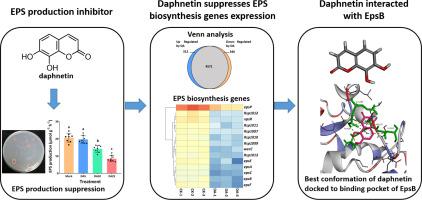Pesticide Biochemistry and Physiology ( IF 4.7 ) Pub Date : 2021-08-14 , DOI: 10.1016/j.pestbp.2021.104948 Liang Yang 1 , Zhouling Wei 1 , Shili Li 1 , Rui Xiao 1 , Qinqin Xu 1 , Yuao Ran 1 , Wei Ding 1

|
Plants deploy a variety of secondary metabolites to fend off pathogen attack. Certain plants could accumulate coumarins in response to infection of bacteria, fungi, virus and oomycetes. Although coumarins are generally considered toxic to microbes, the exact mechanisms are often unknown. Here, we showed that a plant secondary metabolite daphnetin functions primarily by inhibiting Ralstonia solanacearum extracellular polysaccharides (EPS) production and biofilm formation in vitro, through suppressing genes expression of xpsR, epsE, epsB and lexM. Indeed, daphnetin significantly impaired virulence of R. solanacearum on tobacco plants. Transcriptional analysis suggested that daphnetin suppresses EPS synthesis cluster genes expression through transcriptional regulator XpsR. And daphnetin alter mainly virulence factors genes involved in type III secretion system, and type IV secretion system. R. solanacearum lacking EPS synthesis genes (epsB and epsC) that do not produce EPS, showed less virulence on tobacco plants. Molecular docking results indicated that the critical residues of domain in the binding pocket of the EpsB protein interact with daphnetin via conventional hydrogen bonding and hydrophobic interactions. Collectively, we found that daphnetin has potential as a novel virulence inhibitor of R. solanacearum, directly regulates EPS synthesis genes expression.
中文翻译:

植物次生代谢产物瑞香素降低青枯病菌胞外多糖产生及毒力因子
植物利用各种次生代谢物来抵御病原体的侵袭。某些植物可以积累香豆素以应对细菌、真菌、病毒和卵菌的感染。虽然香豆素通常被认为对微生物有毒,但其确切机制通常是未知的。在这里,我们表明植物次生代谢产物瑞香素的作用主要是通过抑制xpsR、epsE、epsB和lexM 的基因表达来抑制青枯病菌胞外多糖 (EPS) 的产生和体外生物膜形成。事实上,瑞香素显着削弱了青枯菌的毒力在烟草植物上。转录分析表明,瑞香素通过转录调节因子 XpsR 抑制 EPS 合成簇基因的表达。而瑞香素主要改变涉及III型分泌系统和IV型分泌系统的毒力因子基因。缺乏不产生 EPS 的EPS 合成基因(epsB和epsC)的青枯菌对烟草植物的毒力较低。分子对接结果表明,EpsB 蛋白结合口袋中结构域的关键残基通过常规氢键和疏水相互作用与瑞香素相互作用。总的来说,我们发现瑞香素具有作为青枯菌新型毒力抑制剂的潜力,直接调节EPS合成基因的表达。



























 京公网安备 11010802027423号
京公网安备 11010802027423号